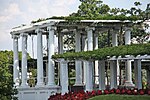Arlington House, The Robert E. Lee Memorial

Arlington House, The Robert E. Lee Memorial, formerly named the Custis-Lee Mansion, is a Greek revival style mansion located in Arlington, Virginia, United States that was once the home of Confederate Army General Robert E. Lee. It overlooks the Potomac River and the National Mall in Washington, D.C. During the American Civil War, the grounds of the mansion were selected as the site of Arlington National Cemetery, in part to ensure that Lee would never again be able to return to his home. The United States has since designated the mansion as a National Memorial. Although the United States Department of the Army controls Arlington National Cemetery, the National Park Service, a component of the United States Department of the Interior, administers Arlington House.
Excerpt from the Wikipedia article Arlington House, The Robert E. Lee Memorial (License: CC BY-SA 3.0, Authors, Images).Arlington House, The Robert E. Lee Memorial
Sherman Drive, Arlington
Geographical coordinates (GPS) Address Nearby Places Show on map
Geographical coordinates (GPS)
| Latitude | Longitude |
|---|---|
| N 38.8821531 ° | E -77.0735239 ° |
Address
Sherman Drive
Sherman Drive
22211 Arlington
Virginia, United States
Open on Google Maps










